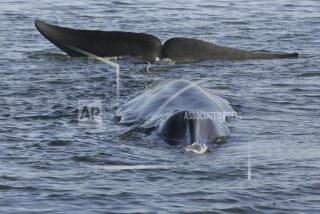Judge OKs Navy Plan to Blast Whales With Sound
HONOLULU — A Navy ship is set to begin blasting high-volume sounds at humpback whales today after a federal judge rejected environmentalists’ arguments that the research program could harm or even kill the endangered animals.
“I do not believe there has been a showing that the test should be prevented,” U.S. District Judge Helen Gillmor said Tuesday.
The Navy hopes to study how the whales react to low-frequency, high-volume noise and then use that data in an environmental impact statement for a new sonar program designed to detect quiet submarines.
Earthjustice Legal Defense Fund, representing several environmental groups, had sued to block the program, saying it would expose whales to sounds so loud that courtship and reproductive activity in the whales’ essential habitat could be disrupted.
Gillmor set a hearing for March 4 on a preliminary injunction to consider the case in more detail, acknowledging the environmentalists’ concerns.
In a sworn statement given before the hearing, one researcher who has studied the whales in Hawaiian waters asserted that “blasting humpbacks with sound of this intensity could kill them.” Marsha L. Green, president of the Ocean Mammal Institute, argued that “to use endangered whales as military sonar targets is a crime against nature.”
The program would focus on male humpbacks off the Kona Coast of the island of Hawaii, a few miles from the border of the newly dedicated Hawaiian Islands Humpback Whale National Marine Sanctuary. The whales spend winters here calving and raising their young before heading to feeding grounds in Alaska in the spring.
The Navy ship plans to locate a singing humpback whale a few miles away and send seven-second pulses of low-frequency sounds toward it while gradually approaching the animal. Scientists would watch for subtle differences in the whale’s behavior and record its vocalizations. The information would be used to determine whether the sonar program could be used in all oceans and what mitigation measures might be needed to protect marine life, according to program manager Joseph Johnson.
“We don’t know at what levels and durations we affect animals,” Johnson said. “If we don’t know, it’s hard to design the program and mitigation measures. It’s sort of a chicken-and-egg thing.”
Transmissions would halt if an animal is observed in acute distress or modifies its behavior significantly. Although noise would not be directed toward any mother-calf pairs in the vicinity, a shore-based research team would also monitor them.
The Navy has completed an environmental assessment, which found that the research program would have no significant impact. It also received a permit from the National Marine Fisheries Service to approach the whales.
“We think this is a very responsible environmental program,” Johnson said. “We’ve had peer review from the scientific marine mammal community. It’s good research.”
More to Read
Sign up for Essential California
The most important California stories and recommendations in your inbox every morning.
You may occasionally receive promotional content from the Los Angeles Times.










